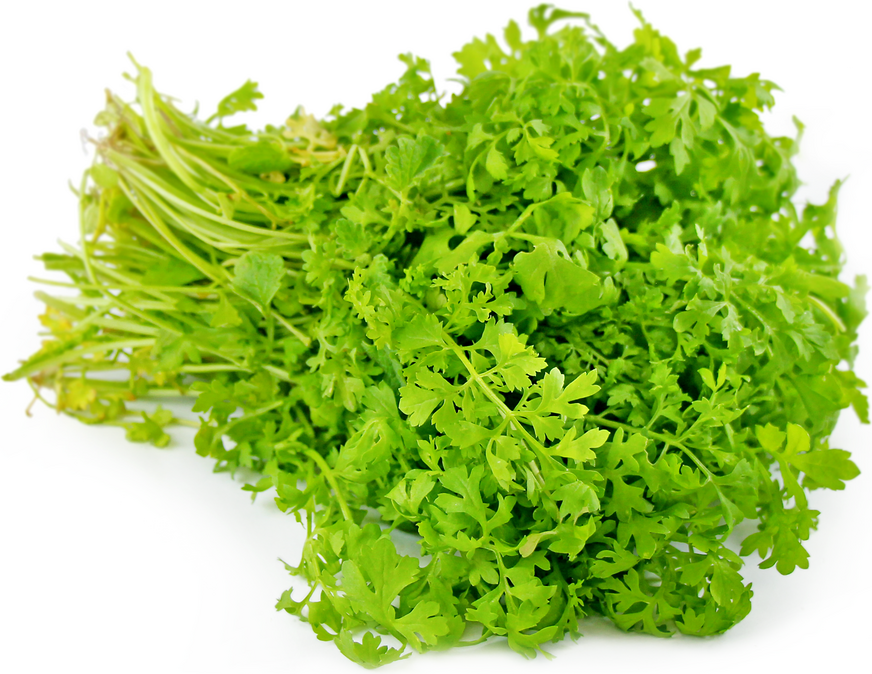


Peppercress
Estimated Inventory, bunch : 0
Description/Taste
Peppercress is a quick-growing, upright, weed-like leafy herb that reaches between 15 to 60 centimeters tall. It has tender bright-green stems with feathery leaves that offer a pungent, herbal and peppery flavor, similar to its relative, watercress. The taste is grassy and earthy at the start, then builds in heat with its peppery spice. Peppercress is edible at all stages of growth, offering distinct levels of spicy heat as the plant’s young shoots are the mildest, while its mature leaves and edible dried seed pods can become quite intense.
Seasons/Availability
Peppercress is available year-round, with peak season in the spring and summer.
Current Facts
Peppercress is botanically classified as Lepidium sativum in the Brassicaceae, or mustard family, and it shares its genus with over 200 species of herbs. The plant’s fresh or dried seed pods are often used to make a peppery seasoning, which earned the plant the nickname Poor Man’s Pepper. Peppercress is also commonly called Peppergrass, Pepperwort, or Garden Cress.
Nutritional Value
Peppercress is a rich source of ascorbic acid, vitamin C, vitamin A, and potassium. It also contains other vitamins and minerals, including iron, phosphorus, and sulfur. Peppercress has expectorant, carminative, and antibacterial properties and has long been used in herbal and folk medicine to treat asthma, coughs, digestive issues, and even topical wounds.
Applications
Peppercress may be used in both raw and cooked applications. In England, cut Peppercress shoots are used in a traditional sandwich made with boiled eggs, mayonnaise, and salt. Peppercress is a good substitute for recipes that call for watercress, and its peppery, tangy flavor is a complex addition to soups and stews. The young sprouts and baby greens are best used raw in salads, and their assertive flavor pairs exceptionally well with mild butter lettuce or hearts of romaine. The raw, tender, young leaves blend easily into pesto, vinaigrettes, marinades, and chimichurri. Larger leaves may be briefly sautéed, blanched, or braised, and their peppery bite is an excellent complement to the sweet flavor of young spring vegetables like peas, asparagus, fava beans, leeks, and baby beets. Peppercress also pairs well with fresh cheeses, herbs such as mint, parsley, tarragon, and chervil, cucumber, potatoes, eggs, and seafood such as salmon, halibut, and shrimp. To store, place fresh Peppercress stem-side down in a glass of water, cover with a plastic bag, and refrigerate for up to five days.
Ethnic/Cultural Info
Peppercress is widely used in Ayurvedic medicine, where it is known by its Sanskrit name, Chandrashura. It is used on its own to treat a range of ailments, notably respiratory and digestive issues, and it is also a key ingredient in Chatrubeeja Churna, an herbal remedy made from the seeds of Peppercress, fenugreek, kalonji, and bishops weed. Chatrubeeja Churna is commonly utilized to relieve bloating, indigestion, and abdominal pain.
Geography/History
Peppercress is believed to be native to the Middle East, specifically to the region of Iran, where it has been cultivated since ancient times. Several species have since spread across the world, many of which are common lawn and field weeds, but Peppercress is actually rare in the wild and instead grows worldwide in home gardens or commercial cultivation, such as in the United States and Europe, notably England, France, the Netherlands, and Scandinavia. Peppercress is easy to grow at home, or it can be found at specialty stores or farmer's markets in the spring and summer.
Recipe Ideas
Recipes that include Peppercress. One




